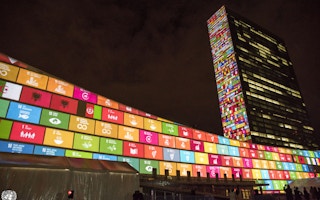Twelve months in, and there’s been some good progress on the Sustainable Development Goals (SDGs) from governments, NGOs and businesses alike: looking at what’s material, making commitments, testing what’s possible and confirming shared roles in delivering these ambitions.
But there’s a missing piece in all this activity, and it’s the glue that holds it all together: systems thinking.
Systems thinking identifies the interactions between different parts of a system – a city, a society, a sector – and ensures they deliver more than the sum of the parts. In today’s world, we’re pretty good at setting goals and then slavishly working to achieve them.
But if the SDGs are really going to shift our whole system onto a sustainable path, we need serious amounts of joined-up thinking that goes deeper to address underlying causes. Successfully delivering the SDGs requires a really strong systems approach.
For organisations rising to the challenge, that means operating on three levels – joining up with others’ efforts to achieve individual goals; looking at the inter-relationships between all the goals; and finally delivering the goals in a way that models the characteristics we need for a sustainable society.
Level 1: Joined-up efforts on individual goals
How are we ensuring that the combined activities across the world on ending poverty or achieving gender equality add up to more than the sum of their parts?
As experienced system change practitioners, the first thing we do at Forum is identify what the system is actually for, where the interlinkages are, and who holds the power, resources and innovations that work for (or against) change.
Understanding the system in detail means we can find and unlock the most powerful opportunities for significant shifts (the nutritional quality of soil, for example, underpins the whole food system). It also means we can start making assumptions about how individual organisational efforts combine, and ensure that all this work is truly complementary.
One year on, and many companies and sectors have identified which goals are material for them, and set their own targets accordingly. But the vital next step is to work collectively with others to better understand the wider system they’re all aiming to fix – be it the global food system, or the use of the oceans – and find the best points of leverage.
It’s essential to make visible and learn from the different individual actions underway so they all add up, or at the very least don’t conflict with each other. This is hard - it requires real collaboration, and real collaboration takes time and resources that may feel at odds with the need for urgency.
If you want to fast, go alone; if you want to go further, go together.
The Marine ColLABoration is a good example of this approach, as it brings together a group of NGOs working on oceans (SDG 14). Instead of acting individually, they’re combining their efforts – working together to reduce plastics at source, for example. These initiatives then need to scale up, perhaps through organisations like the World Ocean Council. It would be amazing to see them map out all the solutions to address SDG 14, from a range of different industries, and discover how they can really work together to create impact at scale.
Level 2: A ‘network set’ of goals
What are the inter-relationships across the goals? How can we understand the different drivers and root causes of a number of different goals regionally, nationally and globally? Which goals work together to deliver a change in a system, and how do we make the most of those combinations? Where are the tensions between them?
Mapping the activities around the individual goals will certainly accelerate progress. But lookingacross the goals at possible synergies and trade-off takes us to the next level. Clearly the SDGs do not work in isolation – health (SDG 3) is impacted by food and nutrition, sanitation, education and increasingly climate change; the sustainability of cities (SDG 11) is an amalgamation of a number of the other goals such as food, energy, education, infrastructure – the list goes on.
David Le Blanc’s ‘network of targets’ clearly demonstrates this (ref: UN DESA Working Paper 141), as does the International Council for Science draft framework for understanding SDG interactions. In the next 14 years we need to rigorously leverage and learn more about these interactions – particularly when looking at the more cross-cutting goals such as sustainable consumption and production, infrastructure and industrialisation, and climate change.
And we need to find ways to do this together. The Foundation, Lankelly Chase, for example, is looking at how the system fits together at a very micro level, through the lived experience of an individual facing many of the challenges the goals address.
“
It’s essential to make visible and learn from the different individual actions underway so they all add up, or at the very least don’t conflict with each other.
National governments should be looking for a joined-up approach, because once they understand how the goals link, it’s easier to see how to develop action and policies to tackle a number at once. At a minimum, as the UN reviews progress against each goal (ref. UN progress report), they should not just track metrics but inter-relationships between them and the learning.
Level 3: The ‘how’ of sustainable development
How are we addressing the Sustainable Development Goals? What are the underlying principles that will drive success?
So here’s the final rub. If today’s global system was working really well for everyone, we wouldn’t need to set goals for ending poverty and hunger. The current system is not set up with sustainable development in mind, so it risks consistently undermining our efforts.
Donella Meadows, a chemist and biophysicist who pioneered systems thinking to tackle economic, environmental and social challenges, proposed twelve leverage points for system change, of which the most impactful involved shifting both the goals of whole systems, and the mindsets and ways of organising within them.
How we go about tackling the SDGs is as important as what we do to tackle them: are we modelling the values and behaviours a sustainable world requires?
That means being inclusive in the activities that we develop and in their governance, it means naming the assumptions we’re making about what will work and in what context, and finally it means getting serious about mindset change and enabling people to take control of their own destiny.
So as we go into the second year of the SDGs, let’s make systems thinking more central to how we address them – individually, as organisations and for the overarching project. We need to be practical– accelerating, rather than blocking action – but with one ultimate end in mind: a sustainable society that works for everyone.
Stephanie Draper is deputy chief executive officer and Asia Pacific executive director, Forum for the Future. This post is republished from Forum for the Future’s blog with permission.











